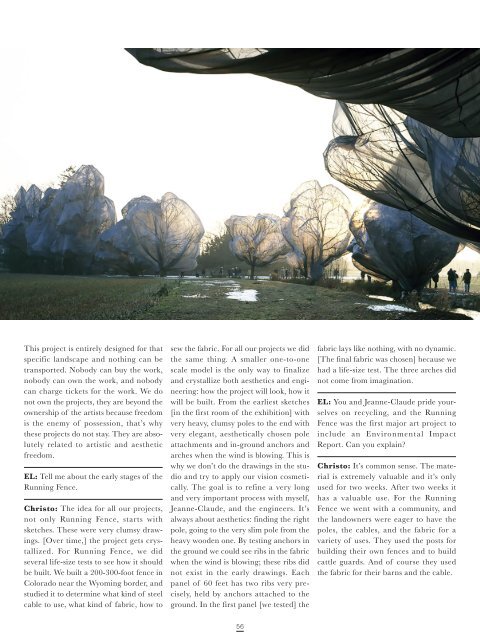Unnatural Nature
You also want an ePaper? Increase the reach of your titles
YUMPU automatically turns print PDFs into web optimized ePapers that Google loves.
This project is entirely designed for that<br />
specific landscape and nothing can be<br />
transported. Nobody can buy the work,<br />
nobody can own the work, and nobody<br />
can charge tickets for the work. We do<br />
not own the projects, they are beyond the<br />
ownership of the artists because freedom<br />
is the enemy of possession, that’s why<br />
these projects do not stay. They are absolutely<br />
related to artistic and aesthetic<br />
freedom.<br />
EL: Tell me about the early stages of the<br />
Running Fence.<br />
Christo: The idea for all our projects,<br />
not only Running Fence, starts with<br />
sketches. These were very clumsy drawings.<br />
[Over time,] the project gets crystallized.<br />
For Running Fence, we did<br />
several life-size tests to see how it should<br />
be built. We built a 200-300-foot fence in<br />
Colorado near the Wyoming border, and<br />
studied it to determine what kind of steel<br />
cable to use, what kind of fabric, how to<br />
sew the fabric. For all our projects we did<br />
the same thing. A smaller one-to-one<br />
scale model is the only way to finalize<br />
and crystallize both aesthetics and engineering:<br />
how the project will look, how it<br />
will be built. From the earliest sketches<br />
[in the first room of the exhibition] with<br />
very heavy, clumsy poles to the end with<br />
very elegant, aesthetically chosen pole<br />
attachments and in-ground anchors and<br />
arches when the wind is blowing. This is<br />
why we don’t do the drawings in the studio<br />
and try to apply our vision cosmetically.<br />
The goal is to refine a very long<br />
and very important process with myself,<br />
Jeanne-Claude, and the engineers. It’s<br />
always about aesthetics: finding the right<br />
pole, going to the very slim pole from the<br />
heavy wooden one. By testing anchors in<br />
the ground we could see ribs in the fabric<br />
when the wind is blowing; these ribs did<br />
not exist in the early drawings. Each<br />
panel of 60 feet has two ribs very precisely,<br />
held by anchors attached to the<br />
ground. In the first panel [we tested] the<br />
fabric lays like nothing, with no dynamic.<br />
[The final fabric was chosen] because we<br />
had a life-size test. The three arches did<br />
not come from imagination.<br />
EL: You and Jeanne-Claude pride yourselves<br />
on recycling, and the Running<br />
Fence was the first major art project to<br />
include an Environmental Impact<br />
Report. Can you explain?<br />
Christo: It’s common sense. The material<br />
is extremely valuable and it’s only<br />
used for two weeks. After two weeks it<br />
has a valuable use. For the Running<br />
Fence we went with a community, and<br />
the landowners were eager to have the<br />
poles, the cables, and the fabric for a<br />
variety of uses. They used the posts for<br />
building their own fences and to build<br />
cattle guards. And of course they used<br />
the fabric for their barns and the cable.<br />
56


